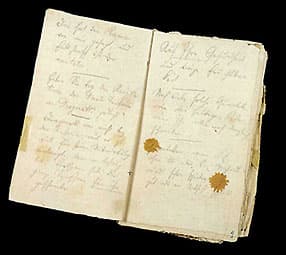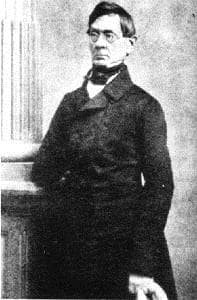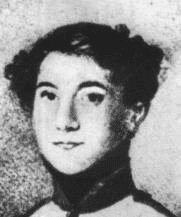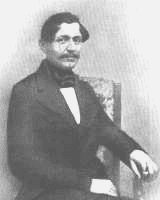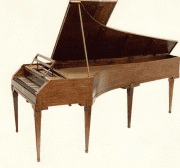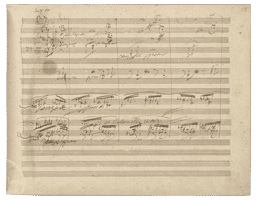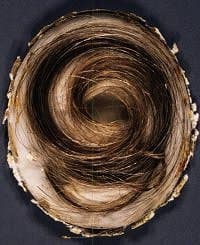Ode To Joy: Part 4 of the Online Learning Guide to Beethoven
Beethoven’s last creative period, often referred to as the mature period, commenced in 1815 and lasted until his death in 1827. Beethoven’s previous “heroic” period, which roughly coincided with the rise and fall of Napolean, was an extremely productive period in his life. The majority of his larger works, particularly his symphonies, were composed during the heroic period. Although Beethoven’s compositional output during this final phase dropped considerably, the compositions during this period are generally larger in scale, deeper in emotional content, and more harmonically adventurous and avant-garde than compositions produced during earlier periods. These final phase compositions more strongly foreshadowed the Romantic Era than those of earlier years.
Beethoven’s final years were difficult for a variety of reasons. Although he began to experience hearing loss as early as the late 1790’s, he was profoundly deaf by 1815. His ability to publicly perform greatly diminished over the years as a result of this hearing loss. Beethoven began relying on ear trumpets designed by his friend, the Viennese inventor Johann Maelzel, in order to maintain some degree of speech recognition.
While the hearing loss was a profound tragedy for Beethoven, it was beneficial to future generations in one respect. During this time, Beethoven employed “conversation books” to aid in communication. The conversation books provided historians tremendous insight into Beethoven’s later years. Individuals who wished to communicate with Beethoven were obliged to write their correspondence in his conversation books during the final decade of his life. Beethoven is known to have possessed over 400 such books at his death.
Unfortunately, Beethoven’s earliest biographer, Anton Schindler, destroyed nearly two-thirds of these conversation books. Schindler’s motivation for such fragrant vandalism is not entirely clear, though most historians believe Schindler hoped to portray Beethoven as a flawless, angelic individual. Schindler took it upon himself to whitewash Beethoven’s image by destroying any material in the conversation books that might reveal perceived character flaws. Not only did Schindler destroy numerous conversation books, he is known to have tampered with the surviving books, even inserting falsified entries after Beethoven’s death to suit his own agenda. Schindler also professed enjoying a very close friendship with Beethoven, a claim Beethoven’s genuine acquaintances disputed. Needless to say, Schindler has been largely discredited as an historian of any merit. The Beethoven Compendium (1991) states: “Schinder’s propensity for inaccuracy and fabrications was so great that virtually nothing he has recorded can be relied on unless it is supported by other evidence.”
During these final years, Beethoven became progressively more reclusive. His legendary disheveled appearance and personal grooming further deteriorated as his temperament became increasingly erratic and volatile. In addition to his hearing problems, Beethoven experienced a number of other physical maladies during his later years. He suffered from various gastrointestinal ailments and liver cirrhosis, likely due to his heavy drinking.
With regard to Beethoven’s personal life, a particularly trying event for Beethoven was the death of his brother Carl in late 1815, and the events which followed that death. Carl had been ill with consumption (i.e., tuberculosis) for some time, and Beethoven spent a small fortune on his care. Carl left a will awarding joint custody of his son to Beethoven and his widow, Johanna. Following Carl’s death, Beethoven immediately embarked on a long and bitter custody battle for sole custody of Carl’s nine-year-old son (also named Karl) on grounds Carl’s widow Johanna was an unfit mother. Beethoven strongly disapproved of Johanna due to reports she had loose morals. Johanna gave birth to an illegitimate child prior to meeting Carl van Beethoven. In addition, Carl and Johanna initially chose to live together until Beethoven coerced them into marrying for decency’s sake.
In 1816, the lower courts awarded Beethoven full custody of Karl. When Johanna appealed, Beethoven pled his custody case to a high court that dealt with individuals of noble birth. He felt the high court would be more sympathetic to his cause than that of his lowly sister-in-law. Beethoven attempted to capitalize on the fact his last name was preceded by “van,” which implied he descended from an aristocratic family, and would therefore be eligible for a hearing at the high court. Use of the German “von” implied a person was of noble birth, but this was not necessarily true for individuals of Dutch descent who incorporated “van” before their last name. Beethoven lost full custody of Karl in 1818 when he inadvertently revealed the “van” in his name did not denote nobility.
Thereafter, Beethoven appealed the high court’s verdict, and went to great lengths in order to prove Johanna was of lowly character, even submitting documentation Johanna was convicted of petty theft as a teenager. In 1820, he regained full custody of Karl. Johanna countered by unsuccessfully pleading her case to the Emperor, who “washed his hands of the matter.” The acrimonious legal battles took a heavy toll on Beethoven’s health and financial resources.
Beethoven’s motivation for dedicating years of his life and spending a small fortune in legal expenses to separate a boy from his mother is unclear. That Beethoven perceived Johanna as entirely incapable of raising a son to adulthood seems unlikely. Many historians believe the aging composer had an overwhelming urge to serve as father figure to a close relative. The celebrated Beethoven scholar Maynard Solomon suggests Beethoven was likely starved for posterity, and would spare no effort to achieve his goal.
Without doubt, Beethoven loved Karl, but in the role of legal guardian, he proved to be a rigid, strict disciplinarian. He enrolled Karl in the most exclusive schools, and demanded that Karl live the highest of moral standards. Beethoven must have been disappointed that Karl demonstrated no aptitude for the piano and was thoroughly disinterested in music. Karl’s life with Beethoven was reportedly a misery for the teenage boy. A pivotal event in their relationship occurred in July, 1826. The twenty-year-old Karl traveled to Baden bei Wien, a fashionable resort town on the outskirts of Vienna he and Beethoven frequently visited. Karl took a pistol, climbed to an abandoned hillside medieval castle, and attempted to shoot himself in the head.
Fortunately, Karl was either a bad aim, or his suicide attempt was half-hearted; the bullet only grazed his scalp. Beethoven was devastated by the suicide attempt. To add insult to injury, Karl insisted on being taken to his mother’s house after the shooting, and refused to see Beethoven during his recuperation. Karl and Beethoven had a chilly reconciliation. Subsequently, Karl enlisted in the army in 1827 against Beethoven’s wishes. Eyewitnesses to their final encounter claim Karl gave Beethoven a stiff, formal handshake and quickly walked away from Beethoven as his army unit departed Vienna. Karl would have been fully aware Beethoven was ill, and the two would likely never meet again, which was indeed the case. Beethoven died a few weeks after Karl’s departure. In spite of Karl’s turbulent upbringing, he apparently thrived once he was out of Beethoven’s reach. Eventually, he married and had four daughters and one son, whom he named Ludwig. He lived comfortably on his Uncle Ludwig’s inheritance for the remainder of his life. He lived long enough to have his photograph obtained. Throughout his life, Karl parted his hair far to one side to hide the scar from his suicide attempt.
A bright spot in Beethoven’s otherwise relatively dark final years was the acquisition of a Broadwood fortepiano in 1817. The piano was still a relatively new instrument during Beethoven’s life. There were numerous piano manufacturers in Vienna during Beethoven’s lifetime, all vying for Beethoven’s endorsement. Although these early Viennese pianos provided a light, quick action, Beethoven was rarely satisfied with the quality of these instruments. Beethoven is known to have broken hammers and strings on these fragile, inadequate pianos.
The London-based Broadwood firm had been producing superior pianos since the late 1700’s. During the summer of 1817, Thomas Broadwood met Beethoven in Vienna. After returning to London, Broadwood asked five accomplished pianists to select the finest instrument from his inventory. The piano then made an arduous, seven-month journey from London to Vienna as a gift to Beethoven. The instrument was considerably larger, more durable, had innovative new foot pedals, and had a wider dynamic and tonal range than any piano he had previously encountered. The Broadwood piano was undoubtedly the inspiration for his monumental piano works during this final phase, including the last five piano sonatas (particularly the well-known Hammerklavier Sonata) and the Diabelli Variations for piano.
“Hammerklavier” segment
[youtube http://www.youtube.com/watch?v=IAwAV7LQeQI&w=420&h=315]
The Broadwood restoration
Other important works from this final phase include the late string quartets, which occupied his efforts until shortly before his death. These quartets are considered the most avant-garde works he ever produced. The quartets went far beyond what musicians and audiences could absorb at the time. Contemporaries found the quartets bewildering, unapproachable, and abstract. They were not widely accepted until long after his death, when they became the source of great inspiration for future composers as diverse as Richard Wagner and Bela Bartok.
[youtube http://www.youtube.com/watch?v=i29LA1fy5r4&w=560&h=315]
Grosse Fuge from opus 130 quartet
However, it is the final symphony of Beethoven’s career, the monumental 9th Symphony, otherwise known as the “Ode to Joy,” that was to be the epic swan song and crowning achievement of his long, illustrious career. The work has become one of the best-known works of the Western classical repertoire. So beloved is the theme from the Ode to Joy that it was adapted for use as the European Anthem in 1972.
The Philharmonic Society of London commissioned the symphony in 1817. Beethoven would labor over the symphony until 1824. Beethoven wanted to incorporate the “Ode to Joy” into a major musical work as early as 1793, when he was only 23 years old. Segments of the 9th Symphony appear in Beethoven’s sketchbooks in 1811 and 1817.
The text from “Ode of Joy” or “An die Freude” was taken from a poem written by Friedrich Schiller in 1785. Schiller (1759-1805) was a beloved German poet, philosopher, historian and playwright. He was a close friend and colleague to Johann Wolfgang von Goethe, arguably the greatest of all Germanic literary figures.
Schiller’s “An die Freude” celebrates the brotherhood and unity of all mankind. The poem, written during the height of the French Revolution, captures the spirit of democracy and celebration of the common man that was sweeping Europe at this time.
The symphony is comprised of four movements. The first three movements are strictly instrumental, but Beethoven employed larger instrumental forces than in any of his prior symphonies. Four solo voices, chorus, and orchestra are employed for the final movement in which the actual “Ode of Joy” text and melody are presented.
From the “Ode to Joy”
The 9th Symphony premiered on May 7, 1824, in Vienna. Beethoven initially hoped to premiere the work in Berlin. He believed the musical atmosphere in Vienna had become too contaminated by a strong “Italian” influence with the recent rise in popular Italian operas, namely those of Gioachino Rossini. The 9th Symphony premiere was a significant event in Beethoven’s life, since he had not given an on-stage appearance in 12 years. Due to his reclusive nature, Beethoven had somewhat faded from the Viennese musical scene over the previous decade, largely due to his poor health, deafness, and preoccupation with his nephew’s custody.
The theater’s Kapellmeister, Michael Umlauf, directed the performance, though Beethoven insisted on sharing the stage with him. After witnessing Beethoven’s highly unsuccessful attempt to conduct his own opera Fidelio two years earlier, Umlauf was aware Beethoven’s attempt at co-conducting could very well end in disaster. To avoid a potential performance debacle, unbeknownst to Beethoven, Umlauf instructed the performers to ignore the entirely deaf Beethoven.
There are a number of anecdotes regarding the premiere of the 9th Symphony. Some claim the piece was shabby and under-rehearsed. Violinist Josepf Böhm recalled:
“Beethoven directed the piece himself; that is, he stood before the lectern and gesticulated furiously. At times he rose, at other times he shrank to the ground, he moved as if he wanted to play all the instruments himself and sing for the whole chorus. All the musicians minded his rhythm alone while playing.”
Nevertheless, the piece was a tremendous triumph. At the conclusion of the piece, Beethoven was still beating his hands furiously in the air though the audience was already applauding. A nearby vocal soloist, Caroline Unger, approached Beethoven on the podium. Caroline, a notable pupil of Aloysia Weber (Mozart’s first love and elder sister of Mozart’s wife, Constanze Weber) had a respectable career as a singer in early 19th century Vienna. However, she will be best remembered throughout history for having turned Beethoven around to face an enraptured audience at his most celebrated final public appearance.
Another eyewitness describes the event:
“The whole audience acclaimed him through standing ovations five times; there were handkerchiefs in the air, hats, raised hands, so that Beethoven, who could not hear the applause, could at least see the ovation gestures.”
The applause lasted for nearly thirty minutes, and was particularly enthusiastic since many in attendance suspected the event might be Beethoven’s final appearance. The applause was so tumultuous and the crowd so enraptured that police agents had to curtail the pandemonium. Beethoven was deeply moved by the event, and considered it one of the most profound moments of his life.
Beethoven’s health declined steadily after the triumphant premiere of the 9th Symphony. He was bedridden for the final few months of his life. Beethoven died on an overcast, stormy morning on March 26, 1827. A close friend, Anselm Hüttenbrenner, and Beethoven’s sister-in-law provided a vivid account of the event. Beethoven’s last recorded words were “Pity, pity-too late!” There has been extensive debate as to the significance of this final statement, with many historians attaching profound meaning to the final utterance. However, documentation explaining the exclamation was uncovered relatively recently. Hüttenbrenner claimed someone drew the dying Beethoven’s attention to a crate of wine sent to Beethoven by his publishers, Breitkopf and Härtel. In uttering that final phrase, Beethoven was lamenting the fact he was too sick to imbibe. A popular account circulated claiming Beethoven shook his fist in the air during a loud thunderclap immediately before his death, but that has never been fully substantiated.
At least two individuals are known to have snipped lockets of hair from Beethoven’s remains, including his infamous biographer, Anton Schindler. One locket of hair, now the property of the Center for Beethoven Studies at San Jose State University, has undergone rigorous, scientific analysis. This analysis has become the source of extensive media coverage, including recent books and documentaries. The attention focused on analytical techniques researchers employed to better ascertain Beethoven’s illnesses and cause of death.
Unlike Mozart’s sparsely attended pauper funeral thirty-six years earlier, Beethoven’s funeral was an enormous affair with estimates between 10,000 to 30,000 mourners lining the streets of Vienna during his funeral procession. Businesses and theaters were closed. A number of notable pallbearers participated in the event, including Beethoven’s well-known students, Carl Czerny and Johann Nepomuk Hummel. Franz Schubert, largely unknown to Beethoven since the former had been too timid to approach the living Beethoven, likewise served as a pallbearer. The young Schubert would follow Beethoven to his grave one year later in 1828.
In the days following his funeral, Beethoven mania reached a feverish pitch. One of Beethoven’s gravediggers claimed he was offered a substantial sum of money for Beethoven’s head, which prompted the placement of guards around his gravesite for several months following his death.
Beethoven will be forever remembered as one of the greatest composers of all time. Nearly all composers that followed him have expressed deep gratitude for his contributions. Indeed, following Beethoven’s death, many 19th century composers felt tremendously inadequate knowing their musical efforts would invariably draw comparison to the great master. Beethoven was the culmination of the Classical Era and did much to usher in the age of Romanticism in music. His creations were the embodiment of a new spirit of humanism and nationalism during a time of intense political upheaval and revolution. He was a master at portraying deep human emotion without the need for spoken text. His legacy will be remembered as one who overcame enormous obstacles to the benefit of countless generations of music lovers.
©Jeffrey Dee Olpin






